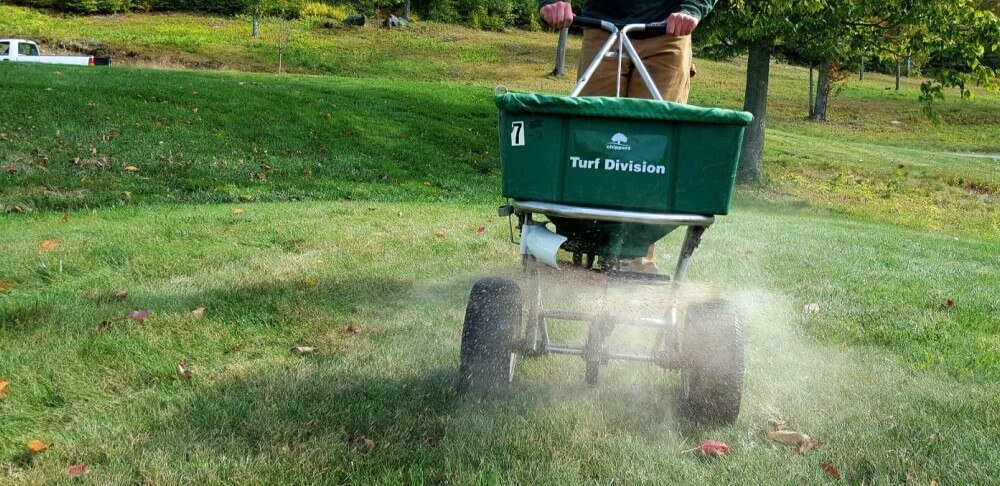As far as your lawn cares, it simply wants some Nitrogen each year to assist in growing and some help if disease or pests are present. Your lawn does not care if the lawn application is liquid or dry. Issues arise only when cost and ease of treatment come into question between lawn care companies. There are pro and cons to each method of fertilizer use, so let’s start with the liquid vs dry debate.
Generally speaking, liquid is more fun to apply, and certainly easier on slopes because carrying a hose is much lighter than 60 lbs. of fertilizer in a spreader. However, the trucks that carry liquid fertilizer are limited to only one or two blends in a given day due to limited tank availability. So, while lots of companies like to say their liquid blends are customized, they are about as customized as everyone getting one or two percent milk that day – you don’t really have a choice. This is an important distinction because granular products come in a huge assortment of blends, so it’s easy to bring along many types associated to differing lawn types and needs. Therefore, due to simple transportation logistics, dry applications are in fact, much easier to “customize”.
For instance, if we take this customized liquid blend theory and apply it in real life, we find out that applying herbicides or even insecticides to a shaded lawn area is not really the appropriate or professional thing to do. Lawn pests don’t live in the shade; lots of lawns in New Hampshire and Vermont have shade. Is it the right thing to do to apply a blend mixed for the day that may be appropriate for a sunny lawn but also is applied on shaded areas? If I take this one step further, I can apply the same theory to fertilizer. Again, shaded grasses only need a fraction of the nitrogen that a sunny area requires. If we take the “custom” liquid blend of fertilizer we are again either over applying the material on shaded lawns or under applying them in the sunny areas. If there is weed control in the premixed liquid application, does it make sense to spray every lawn for weeds even if they have none? Think about these facts for a moment and let them sauté and slowly sink in; then decide what “custom” really means to you as the consumer. It means you get what’s on the truck for the day.
What about the claim that granular fertilizer makes a mess; it gets all over your walkway, patio and into flowerbeds. Mercy, there must be fertilizer everywhere! This might be true if the applicator is sloppy and fails to use the spreader guard device that is designed to deflect material going in unwanted directions. Furthermore, one of the three spreader ports is supposed to be closed when trimming. As a final counter point to granular treatments being messy, most professional companies carry landscape blowers with them and even if the preceding two procedures fail, the blower moves the product onto the lawn where it is intended to be used. Driveways have little use for fertilizer. One other note, most natural and organic fertilizers benefit flowers, trees, and ornamental shrubs in and around a landscape. On the other hand, pesticides in mulch beds or other areas are considered “off target” and are technically illegal in the eyes of state regulators in either Vermont or New Hampshire. Even liquid sprays can drift from wind or applicator error onto driveways, walkways and other non-lawn areas except the spray cannot be removed. There are no best applications here, only proper control of the equipment being used when it comes to liquid vs. dry materials.
When I read how liquid fertilizer is easier to absorb, I think of feeding my child baby food…this is silliness. Turf will green up faster with a liquid treatment but the same application of dry will provide the same level of green and they will both last the same amount of weeks. The key is how much nitrogen (N) is in the mix? Nitrogen is expensive, and the more you get, the more it costs. As I stated earlier, if the lawn truck is going out with .75#N in its liquid tank, everyone is getting that blend for the day. Do you like vanilla? I hope so. On the other hand, granular treatments can be adjusted and modified to each client. One lawn may be new and require a higher dose of N, say more like 1.25#N, while a shaded area may only require .5#N.. This type of practice cannot be achieved with liquid batches in mini-tanker trucks like larger lawn care companies. In fact, slow-release fertilizers are great for not stressing out lawns when it comes to heat or diseases. Think again when you hear about liquid fertilizers being easy to absorb and use.
My last point is about pesticides being used in a liquid formulation on lawns. Why do we need to spray so many pesticides when it may or may not be required? Does it make sense to say insecticides are more easily absorbed into turf when many work on contact and not in the plant itself?
My grassy friends, there is no right or wrong answer here – only choices. This is science, not sales. You decide what makes sense and then vote with your wallet on this and many other lawn care topics. Thank you for reading and I wish you all the best with your liquid or dry lawn products!

Liquid vs. Dry Lawn Treatments
Tags:
Chemlawn
, chippers
, Fertilizer
, lawn companies
, trugreen
, turf
, lawnmaster
, new london lawn care
, granular fertilizer
, liquid fertilizer

